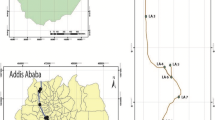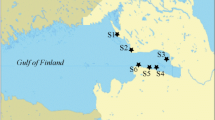Abstract
A study was made of water, sediments and invertebrates in the R. Derwent, North-East England, at one site above and three sites below a stream bringing in high concentrations of Zn, Cd and Pb derived from an active fluorspar mine. The mean concentrations of these metals in filtrable water at the unpolluted site were 0.020, <0.0003, 0.005 mg l-1, respectively, while those at the first polluted site were 0.29, 0.0006, 0.016 mg l-1. The benthic macroinvertebrate fauna was dominated by insects; all taxa present at the unpolluted site were represented at one or more of the polluted sites. In almost all cases the elevated concentrations of metals in water and sediments at polluted sites were paralleled by higher concentrations in animals. Significant positive correlations were demonstrated between metal concentrations in certain taxa and those in their environment e.g. Ecdyonurus venosus and aqueous Pb. Mayflies tended to concentrate Zn, Cd and Pb to higher levels than other groups. Comparison of carnivorous species with other taxa revealed no indication of increased metal concentrations at higher trophic levels.
Similar content being viewed by others
References
Abel, P. D. & Green, D. W., 1981. Ecological and toxicological studies on invertebrate fauna of two rivers in the Northern Pennine Orefield. In: Say, P. J. & Whitton, B. A. (eds). Heavy Metals in Northern England: Environmental and Biological Aspects. Univ. Durham, Dep. Bot.: 109–122.
Armitage, P. D., 1977. Invertebrate drift in the regulated R. Tees and an unregulated tributary, Maize Beck, below Cow Green Dam. Freshwa. Biol. 7: 167–183.
Armitage, P. D., 1980. The effects of mine drainage and organic enrichment on benthos in the River Nent system, Northern Pennines. Hydrobiologia 74: 119–128.
Armitage, P. D., McHale, A. M. & Crisp, D. C., 1975. A survey of the invertebrates of four streams in the Moor House National Nature Reserve in Northern England. Freshwat. Biol. 5: 479–495.
Boon, P. J., 1978.The use of ventral sclerites in the taxonomy of larval hydropsychids. 2nd int. Symp. Trichoptera. Junk, The Hague, 165–173.
Brindle, A., 1960. The larvae and pupae of the British Tipulinae (Diptera, Tipulidae). Trans. Soc. br. Ent. 14: 63–114.
Brindle, A., 1967.The larvae and pupae of the British Cylindrotominae and Limoniiae (Diptera, Tipulidae). Trans. Soc. br. Ent. 17: 151–216.
Brooker, M. P. & Morris, D. L., 1980. A survey of the macroinvertebrate riffle fauna of the rivers Ystwyth and Rheidol, Wales. Freshwat. Biol. 10: 459–474.
Brown, B. E., 1977a. Effects of mine drainage on the River Hayle, Cornwall. A) Factors affecting concentrations of copper, zinc and iron in water, sediments and dominant invertebrate fauna. Hydrobiologia 52: 221–233.
Brown, B. E., 1977b Uptake of copper and lead by a metal-tolerant isopod Asellus meridianus Rac. Freshwat. Biol. 7: 235–244.
Bryce, D. & Hobart, A., 1972. The biology and identification of the larvae of the Chironomidae. Ent. Gaz. 23: 175–217.
Burrows, I. G., 1981. Accumulation of heavy metals by organisms in the Derwent catchment. M.Sc. Thesis, Univ. Durham, Engl., 258 pp.
Carpenter, K. E., 1922.The fauna of the Clarach stream (Cardiganshire) and its tributaries. Aberyst. Stud. 4: 251–258.
Carpenter, K. E., 1924. A study of the fauna of rivers polluted by lead mining in the Aberystwyth district of Cardiganshire. Ann. appl. Biol. 11: 1–23.
Carter, J. G. T. & Nicholas, W. L., 1978.Uptake of zinc by the aquatic larvae of Simulium ornatipes (Diptera: Nematocera). Aust. J. mar. Freshwat. Res. 29: 299–309.
Davies, L., 1968. A key to the British species of Simuliidae (Diptera) in the larval, pupal and adult stages. Sci. Publs Freshwat. biol. Ass. 24, 126 pp.
Dean, J. M., 1974. The accumulation of 65Zn and other radionuclides by tubificid worms. Hydrobiologia 45: 33–38.
Dodge, E. E. & Theis, T. L., 1979. Effect of chemical speciation on the uptake of copper by Chironomus tentans. Envir. Sci. Technol. 13: 1287–1288.
Elliott, J. M., 1977. A key to the larvae and adults of British freshwater Megaloptera and Neuroptera. Sci. Publs Freshwat. biol. Ass. 35, 52 pp.
Elliott, J. M., O'Connor, J. P. & O'Connor, M. A., 1979. A key to the larvae of Sialidae (Insecta: Megaloptera) occurring in the British Isles. Freshwat. Biol. 9: 5112514.
Elwood, J. W., Hildebrand, S. G. & Beauchamp, J. J., 1976.Contribution of gut contents to the concentration and body burden of elements in Tipula spp. from a spring-fed stream. J. Fish. Res. Bd Can. 33: 1930–1938.
Eyres, J. P. & Pugh-Thomas, M., 1978. Heavy metal pollution of the River Irwell (Lancashire U.K.) demonstrated by analysis of the substrate materials and macro-invertebrate tissue. Envir. Pollut.16: 129–136.
Getsova, A. B. & Valkova, G. A., 1962. The accumulation of radioactive isotopes by certain aquatic insects. Ent. Rev. (U.S.S.R.) 41: 61–70(English translation).
Harding, J. P. C. & Whitton, B. A., 1978. Zinc, cadmium and lead in water, sediments and submerged plants of the Derwent Reservoir, Northern England. Wat. Res. 12: 307–316.
Hickin, N. W., 1967. Caddis larvae: larvae of the British Trichoptera. Hutchinson, Lond., 476 pp.
Hildrew, A. G. & Morgan, J. C., 1974. The taxonomy of the British Hydropsychidae (Trichoptera). J. Ent. B 43: 217–229.
Hiley, P. D., 1976. The indentification of British limnephilid larvae (Trichoptera). Syst. Ent. 1: 147–167.
Holland, D. G., 1972. A key to the larvae, pupae and adults of the British species of Elminthidae. Sci. Publs Freshwat. biol. Ass. 17, 92 pp.
Hynes, H. B. N., 1977. A key to the adults and nymphs of the British stoneflies (Plecoptera) (3rd ed.). Sci. Pubis Freshwat. biol. Ass. 17, 92 pp.
Jones, J. R. E., 1940. A study of the zinc-polluted river Ystwyth in north Cardiganshire, Wales. Ann. Appl. Biol. 27: 367–378.
Jones, J. R. E., 1949. An ecological study of R. Rheidol. J. anim. Ecol. 18: 67–88.
Jones, J. R. E., 1950. A further ecological study of the R. Rheidol: the food of the common insects of the main stream. J. anim. Ecol. 19: 159–174.
Jones, J. R. E., 1958. A further study of the zinc-polluted river Ystwyth. J. anim. Ecol. 27: 1–14.
Jones, A. N. & Howells, W. R., 1975. The partial recovery of the metal polluted R. Rheidol. In: Chadwick, M. J. & Goodman, G. T. (eds). The Ecology of Resource Degradation and Renewal. 15th Symp. British Ecological Soc. Blackwell Scientific Publications, Oxford: 443–459.
Laurie, R. D. & Jones, J. R. E., 1938. The faunistic recovery of a lead polluted river in north Cardiganshire, Wales. J. anim. Ecol. 7: 272–289.
Macan, T. T., 1959. A Guide to Freshwater Invertebrate Animals. Longmans, Lond., 118 pp.
Macan, T. T., 1979. A key to the nymphs of the British species of Ephemeroptera with notes on their ecology (3rd ed.). Sci. Publs Freshwat. biol. Ass. 17, 92 pp.
Mackereth, J. C., 1954. Taxonomy of the larvae of the British species of the genus Rhyacophila (Trichoptera). Proc. r. ent. Soc. Lond. 29: 147–152.
Mathis, B. J. & Cummings, T. F., 1973. Selected metals in sediments, water and biota in the Illinois River. J. Wat. Pollut. Comr. Fed. 45: 1573–1583.
Namminga, H. E., Scott, J. E. & Burks, S. L., 1974. Distribution of copper, lead and zinc in selected components of a pond ecosystem. Proc. Okla. Acad. Sci.54: 62–64
Namminga, H. & Wilhm, J., 1977. Heavy metals in water, sediments and chironomids. J. Wat. Pollut. Contr. Fed. 49: 1725–1731.
Nehring, R. B., 1976. Aquatic insects as biological monitors of heavy metal pollution. Bull. envir. Contam. Toxicol. 15: 147–154.
Nicholas, W. L. & Thomas, M., 1978. Biological Release and Recycling of Toxic Metals from Lake and River Sediments. Australian Water Resources Council Technical Paper 33. Dep. natn. Dev., Canberra, 99 pp.
Patrick, F. M. & Loutit, M., 1976. Passage of metals in effluents, through bacteria to higher organisms. Wat. Res. 10: 333–335.
Rawlinson, R., 1939. Studies on the life history and breeding of Ecdyonurus venosus (Ephemeroptera). Proc. zool. Soc. B 109: 377–450.
Say, P. J. & Giani, N., 1981. Accumulation of zinc by oligochaetes and chironomids. Acta Oecol. 2: 339–355.
Wright, D. A., 1980. Cadmium and calcium interactions in the freshwater amphipod Gammarus pulex. Freshwat. Biol. 10: 123–133.
Author information
Authors and Affiliations
Rights and permissions
About this article
Cite this article
Burrows, I.G., Whitton, B.A. Heavy metals in water, sediments and invertebrates from a metal-contaminated river free of organic pollution. Hydrobiologia 106, 263–273 (1983). https://doi.org/10.1007/BF00008125
Received:
Accepted:
Published:
Issue Date:
DOI: https://doi.org/10.1007/BF00008125




